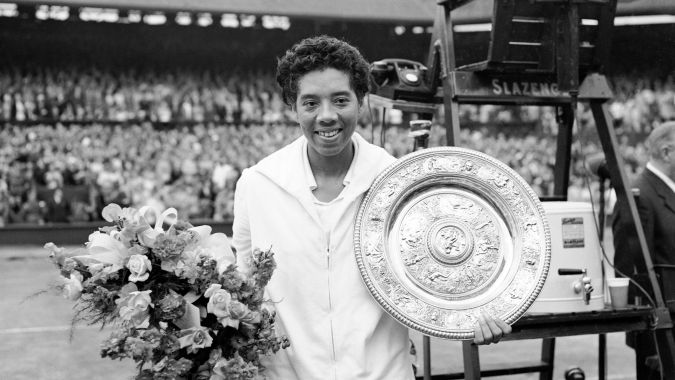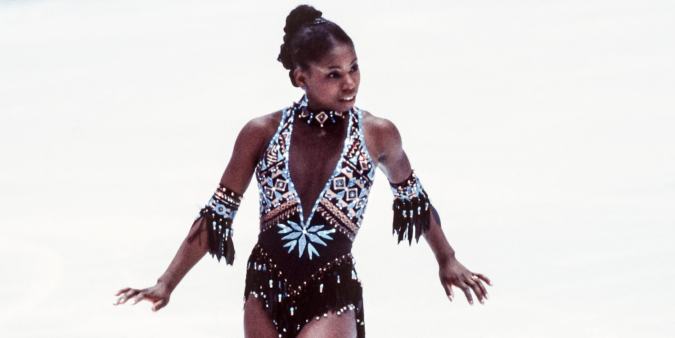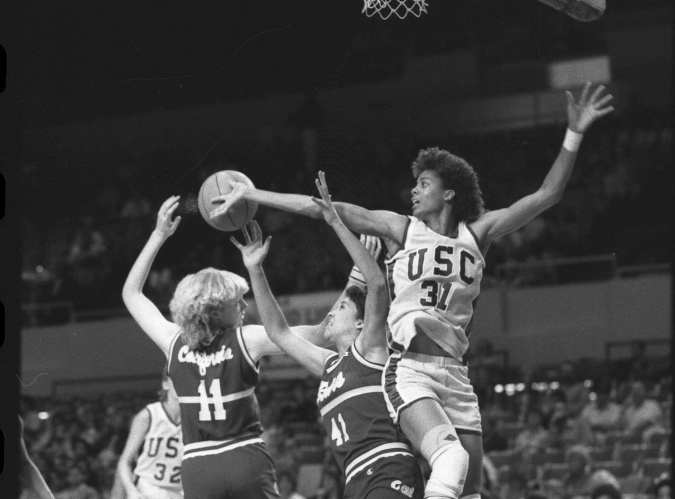History Makers: Black Women, One of One
Althea Gibson: Breaking Barriers, Inspiring Generations Althea Gibson’s story is one of defiance, resilience, and sheer determination

Althea Gibson: Breaking Barriers, Inspiring Generations

Althea Gibson’s story is one of defiance, resilience, and sheer determination. Born in Harlem on August 25, 1927, she grew up at a time when racial segregation was still deeply embedded in American society. The odds were stacked against her—an African American woman, raised in poverty, with few opportunities to pursue her dreams. But despite these overwhelming challenges, Gibson became not only one of the greatest tennis players of her era but also a powerful symbol of possibility for Black women everywhere.
Althea’s journey to tennis stardom wasn’t a traditional one. Growing up, sports weren’t part of her family’s everyday life, but she was drawn to the Harlem River Tennis Courts by a city program that introduced young people to the game. At first, the game was unfamiliar, and the world of tennis was a space that seemed reserved for white, affluent players. But Gibson’s natural athleticism was undeniable. She poured herself into tennis with unyielding focus and dedication, determined to prove her worth in a world that had no place for women like her.
In 1950, Althea Gibson made history by becoming the first African American to compete in the U.S. National Championships (now known as the U.S. Open). This was no small feat. At the time, the sport was seen as almost exclusively white, and the very idea of a Black woman playing in such prestigious tournaments was met with resistance. Yet, Gibson’s entry into the tournament was a bold statement, one that said she was here to stay. And though she didn’t win that first year, the world had taken notice.
Her breakthrough came in 1956 when she made history once again by winning the French Open, becoming the first African American to win a Grand Slam title. That victory wasn’t just a win for her—it was a win for every Black woman who had ever dreamed of something bigger, something beyond the narrow confines of what society said was possible. It was a declaration that barriers could be broken.
But Gibson’s journey didn’t stop there. In 1957, she became the first African American to win Wimbledon, followed by a second Wimbledon title in 1958. She also won the U.S. National Championships in 1957 and 1958, firmly establishing herself as one of the greatest athletes in the world. Her powerful serve, unmatched athleticism, and ability to stay calm under pressure were key to her success. But it was her courage, her ability to step onto courts where she was not welcomed, and her unapologetic excellence that truly set her apart.
For Black women, Althea Gibson was a revelation. She showed them that their dreams were valid, that they had a place in spaces where they were often invisible. Her success on the tennis court was not just a personal triumph—it was a signal to the world that Black women could compete, excel, and change the game, no matter how high the hurdles.
Gibson’s impact went far beyond her athleticism. As the first Black woman to dominate in a sport that had largely been closed off to people of color, she became a beacon of hope. She demonstrated that through grit and determination, anything was possible. She opened doors for future generations of Black women in sports, inspiring them to chase their dreams without fear or hesitation.
Even after retiring from tennis, Althea didn’t fade into the background. She went on to play professional golf and became a respected mentor, continuing to encourage young athletes to break boundaries. Her legacy endures today in the countless Black women who have followed in her footsteps—whether in tennis, athletics, or other fields.
Althea Gibson’s story serves as a powerful reminder of the importance of representation, perseverance, and resilience. She proved that Black women have the strength to shatter barriers and the power to inspire generations. Her legacy is a testament to the indomitable spirit of those who refuse to accept limits, showing the world what can happen when we dare to dream.
Surya Bonaly: Breaking Ice, Shattering Boundaries

In the glittering, elegant world of figure skating, one name stands out—not just for her unparalleled athleticism, but for the way she broke down barriers and reshaped the sport for generations of Black women around the world. Surya Bonaly’s journey to the top of figure skating wasn’t an easy one, but it was one marked by defiance, determination, and an unyielding belief that she belonged at the highest levels of the sport. As we celebrate International Women’s Month, Surya Bonaly’s legacy offers a powerful reminder of what it means to challenge expectations and carve your own path.
Born on December 15, 1973, in Nice, France, to a French mother and a father from the Comoros Islands, Bonaly’s introduction to figure skating was nothing short of unconventional. Growing up, she was surrounded by the world of gymnastics and acrobatics, which influenced her unique style on the ice. Unlike most of her peers, who were trained in the more traditional elements of figure skating, Surya was determined to bring something different to the sport. She didn’t just want to perform the graceful, balletic routines that were expected of women skaters—she wanted to defy the norms and infuse her performances with athleticism and daring, turning the ice into a stage for bold, groundbreaking moves.
By the early 1990s, Surya Bonaly had already made her mark on the international stage, but it was her audacious approach to figure skating that truly set her apart. Most famously, in 1991, she became the first woman in the history of figure skating to land a backflip on the ice in competition—a feat so daring that it was initially banned by the sport’s governing body. Yet, despite the controversy, Bonaly’s defiant act became a symbol of her unapologetic approach to skating. She wasn’t content to conform to the delicate, prim-and-proper expectations of figure skating. Surya was rewriting the script—showing the world that figure skating could be as daring as it was graceful.
For Black women in the world of figure skating—a sport that had long been dominated by white athletes—Bonaly’s rise was nothing short of revolutionary. She wasn’t just breaking athletic boundaries; she was challenging the racial and cultural norms of a sport that had largely been seen as inaccessible to people of color. Surya’s success on the ice, coupled with her fierce individuality, inspired a new generation of Black girls to pursue their dreams in a space where they had been overlooked or excluded for so long. In a sport where diversity was almost nonexistent, Surya Bonaly proved that Black women could thrive, excel, and redefine what was possible.
Despite the odds stacked against her, Bonaly’s career was filled with stunning accomplishments. She earned five European Championship titles, nine French National titles, and was a three-time World Championship medalist. Her performances at the Winter Olympics were unforgettable, though she never took home the gold she so clearly deserved. Still, Bonaly’s skill, athleticism, and emotional depth brought her worldwide acclaim, earning her the respect of fans and competitors alike.
But Surya Bonaly’s impact went far beyond her competitive achievements. She shattered the notion that figure skating was about soft, graceful performances. She brought strength, power, and athleticism to the sport, paving the way for future skaters to explore new forms of expression. Her defiance in the face of adversity became a defining characteristic of her career, and her unwillingness to conform made her a trailblazer for women of color not just in figure skating, but in sports globally.
Today, Surya Bonaly’s legacy is one of profound influence. She inspired a generation of athletes, especially Black women, to see figure skating as a space they too could inhabit and excel in. Her journey proves that no matter how unconventional your approach, no matter how many times you’re told “no,” the power to change the game lies within you. She wasn’t just skating to win titles; she was skating to prove that barriers could be broken, that the ice could be a stage for stories that had never been told before.
As we honor Surya Bonaly during International Women’s Month, we celebrate her not just for her incredible skill and accomplishments, but for the way she challenged the world to expand its definition of who belongs in sports. She remains an icon of strength, resilience, and the power of individuality—reminding every Black woman that she too can break the ice, shatter expectations, and leave her mark on the world.
Cheryl Miller: Redefining the Game for Women in Basketball

In the world of basketball, there are players who leave a mark, and then there are legends who change the very fabric of the game. Cheryl Miller is one of those legends—a name that forever altered the landscape of women’s basketball and inspired countless Black women to dream bigger and reach higher. As we celebrate International Women’s Month, it’s only fitting to honor her legacy and reflect on how she transformed not only basketball but the possibilities for women of color in sports.
Growing up in Riverside, California, Cheryl was no stranger to competition. Her brother, Reggie Miller, would later become an NBA Hall of Famer, but long before he became a household name, Cheryl was already making waves. The Miller family was no stranger to the game—basketball was in their blood. But it was Cheryl, with her exceptional talent and determination, who would blaze a trail that few could imagine at the time.
By the time she stepped onto the University of Southern California’s campus in the early 1980s, Cheryl Miller was a force to be reckoned with. Standing at 6’2″, she played with a grace, power, and intelligence that made her a unique presence on the court. Her college career was nothing short of extraordinary—leading USC to two NCAA championships and earning countless accolades. But it wasn’t just her scoring ability that set her apart; it was her complete dominance of the game. She could dribble, pass, defend, and shoot with precision, and her basketball IQ was off the charts. She wasn’t just playing; she was redefining what it meant to be a woman in the sport.
Then came the moment that shocked the world. Cheryl Miller became the first woman to dunk during a game—an act that wasn’t just a statement of athleticism but a challenge to the norms of women’s sports. At the time, women’s basketball wasn’t given the same attention or respect as the men’s game, but Cheryl’s dunk was a defining moment. It was a declaration: women could play at the same level, with the same intensity, as their male counterparts. That dunk wasn’t just a physical feat; it was a cultural shift.
Cheryl didn’t just break records—she broke down barriers. In 1984, she led Team USA to a gold medal at the Los Angeles Olympics, where her incredible talent and leadership were showcased on the world stage. As the spotlight grew brighter, Cheryl became a role model for countless young women—particularly young Black women—who had never seen someone like her in the world of sports. She showed them that the impossible was possible.
However, despite her legendary career, Cheryl Miller didn’t receive the same level of recognition or financial reward that male athletes did. The Women’s National Basketball Association (WNBA) hadn’t yet been founded, and the women’s game was often overlooked. But Cheryl’s passion never wavered. She wasn’t in it for the accolades—she was in it to prove that women belonged on the highest stages of the sport. And, in doing so, she made a lasting impact on the game.
After retiring from playing, Cheryl’s story didn’t end. She transitioned into coaching and broadcasting, roles that allowed her to continue shaping the future of basketball. As the head coach of USC’s women’s basketball team, she mentored young athletes, imparting not just basketball skills but life lessons. She became a powerful voice for women’s sports, especially Black women, showing them that their voices and talents mattered. As a commentator, Cheryl brought her insight and experience to millions of viewers, giving women’s basketball a platform it had never truly had before.
Today, Cheryl Miller’s legacy is undeniable. She is a pioneer who didn’t just change the game of basketball; she changed how the world viewed women in sports. For Black women watching her rise, Cheryl’s success was a beacon of hope, a reminder that talent, resilience, and grit could break through any wall, no matter how high.
We celebrate Cheryl Miller not just for her unparalleled skills on the court, but for being a trailblazer—someone who proved that women, and particularly Black women, could not only compete but thrive in spaces where they had been previously excluded. Her story continues to inspire the next generation of athletes, reminding us all that when we dream big and work tirelessly, we can change the game for good.



